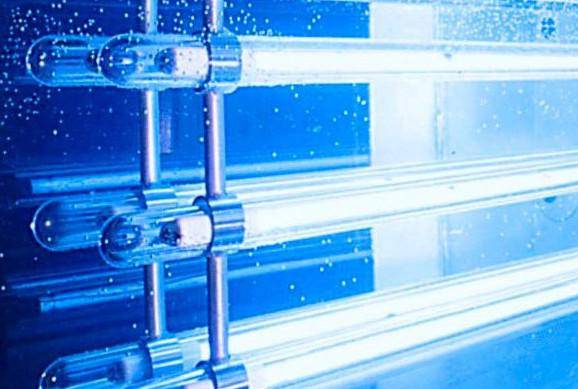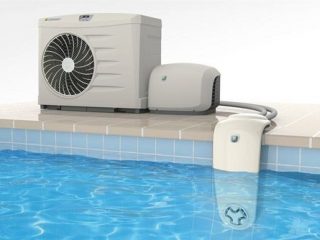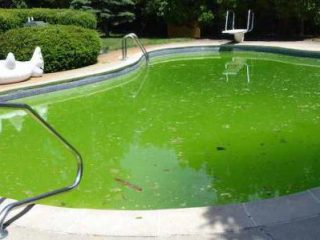Content
Regardless of the type of pool, the bowl and water will have to be cleaned at the beginning and end of the season. The procedure may become more frequent with intensive use of the hot tub. In summer, daily cleaning of the outdoor pool is required. Closed hot tubs become less dirty, but the water needs to be changed over time. There are many cleaning methods. The choice of the appropriate procedure depends on the design, material and volume of the bowl.
Large waste collection kits
In private courtyards and summer cottages, swimming pools with a maximum diameter or length of 4.5 m are usually installed. Along with the bowl, the owner will need a pool cleaning kit to collect leaves and other large debris in the water. The simplest kit consists of a net and a small skimmer - a vacuum cleaner that sucks up debris using a pump. All attachments are equipped with a telescopic rod, allowing you to reach any area in the pool.
Robot vacuum cleaners
Large volumes of cleaning can be handled by a pool robot, which is capable of independently cleaning every square centimeter of the bottom. The device is a vacuum cleaner. The difference from the manual model is that there is no need for control. The robot is simply immersed in water, plugged into an outlet, and waits for the job to finish. The vacuum cleaner will do everything itself in a matter of minutes. At the end of the work, the owner will only have to remove the filter bag, clean it of dirt and put it back in place.
The robot vacuum cleaner will keep the pool clean throughout the season. An additional advantage is the increase in the service life of water filter elements. The cartridges will have to be changed less often, since most of the dirt from the pool will be collected by the robot.
The video shows a clean pool without the use of chemicals:
Chemicals
Pool cleaning chemicals come in the form of liquid, powder, and tablets. Most often, disinfection of the font is carried out comprehensively. The products are added to the water after mechanical cleaning. An integrated approach destroys all harmful microflora in the water.
Organic and inorganic sediments in the pool are destroyed by coagulants. The chemical belongs to the active group. Coagulants destroy the nutrient medium in water that promotes the growth of bacteria.
The water in the pool will remain clean longer after treatment with chlorine and active oxygen.
Among the popular chemistry for water purification are the following:
- Factory-made preparations containing active oxygen are considered the most harmless means for water purification. Despite the high level of safety, manufacturers recommend following the dosage.
- Preparations containing chlorine are usually available in tablet form. A plastic or special powder coating prevents rapid dissolution in water. Chlorine-based products are effective for cleaning hot tubs, but are dangerous for humans.
- Cleaning preparations containing bromine pose less of a threat to human health. After using them, there is no pungent odor in the pool. In case of contact with the mucous membrane or body, no chemical burns occur.
- Blue crystals of copper sulfate are often used as a folk remedy for cleaning pools. The drug reacts with harmful impurities in water and destroys them.
- For bactericidal water purification, silicon or shungite is placed at the bottom of the font. During the treatment, harmful microorganisms and some minor contaminants are destroyed.
A method of water disinfection that uses ozone or UV rays, as well as silver and copper plates, is considered harmless. However, when cleaning a pool at a dacha, such methods are rarely resorted to because of their high cost.
Basic cleaning methods
To know how to clean a pool, you need to determine the degree of contamination, and then choose the appropriate method. It is important to take into account one rule: cleaning must restore the aesthetic appearance of the font and at the same time be safe for humans.The original pool cleaning system, consisting of a filter, only catches dirt. It will not cope with bacteria and large debris floating in the water.
Chemical method
Circulating water through a filter does not remove cloudiness. Simple cleaning of a pool at the dacha is usually done with cheap chemicals. Chlorine is most often used. The aggressive substance destroys nitrogenous compounds and most pathogenic microorganisms, but some bacteria in the water survive.
Bromine is less safe for cleaning hot tubs. The drug acts no weaker than chlorine, but not every summer resident can afford it. The safest option for disinfecting a country pool is to use active oxygen.
To quickly clean the bottom and walls of the font from mucus, add a double portion of one of the preparations. During chemical cleaning, water is not drained. You can find out without analysis that it is time to clean the pool by the change in the color of the water. The liquid becomes opaque, acquiring a green or milky tint.
The result of cloudy water in the font is the proliferation of harmful bacteria. Pollution is considered biological and poses a danger to humans no less than exposure to chlorine. Microorganisms infect the skin of a bathing person, and when they enter the digestive organs they cause diseases. Green water can even burn the mucous membrane.
Water becomes green as a result of the proliferation of small algae. Algaecides help destroy the enemy. After treatment, the water will become clear, but you still cannot swim in it.Even in crystal clear liquid, pathogenic microorganisms remain alive. Fungi are especially dangerous. After adding algaecides, the water is re-purified with disinfectants.
The water in the font becomes cloudy for several reasons. The most common case is associated with simple clogging with dust, pollen from flowering plants, as well as other small debris that a standard filter cannot catch. Coagulants are used to clean the pool. The preparations transform small particles into large flakes that settle to the bottom of the font. When the cloudy water becomes clear, the sediment is collected with a vacuum cleaner.
Microorganisms can cause cloudy water. The solution to the problem is conventional disinfection with chemicals.
If the measures taken did not produce positive results, the reason lies in the composition of the water. A complete analysis will have to be carried out in the laboratory. Cloudy water can be due to the chemical composition, acid balance, or mineral impurities.
Sometimes the water in the pool can take on a rusty tint. The reason is the high content of iron impurities in the natural source. When pumping from a well, water is forced through a filter. If the results are poor, coagulants are added to the pool to clean it. The sediment that falls in flakes is collected with a vacuum cleaner.
Mechanical method
When considering how to clean a pool mechanically, you should first focus on hand tools.Standard cleaning equipment you will need:
- Brush. Use hand tools to collect fluff floating on the water, accumulations of fat or dirt.
- Net. The tool resembles a device for catching fish or butterflies. A net is used to collect floating leaves, grass and other large debris.
- Skimmer. A small vacuum cleaner with a brush collects small debris floating on the water and settled on the walls of the font. By design, skimmers are of mounted and floating types.
Mechanical cleaning of the pool is performed at least once every three days. In case of intense water contamination, the procedure is carried out daily. It is impossible to do without mechanical cleaning of the swimming pool, even if modern cleaning systems are used with the pool.
It will not be possible to remove dirt impurities dissolved in water with a hand tool. Filters cope with this task. To operate them you need a pump. The most common are two types of water filters:
- The sand filter effectively purifies water from small impurities that form silt and cloudiness of the liquid. From the name it is clear that the filler is sand. The filter is suitable for most types of pools. Contaminated sand is changed over time or tried to be washed with clean water.
- A filter with a cartridge is capable of catching the smallest particles. The system is considered advanced, easy to maintain, but expensive. The service life of the cartridge depends on the material of manufacture.
Reusable water purification cartridges can be washed, while disposable ones can be disposed of immediately. The most effective is considered to be a model where the filter layer is a diatomaceous earth filler made from crushed shell rock. The disadvantage is the high cost, and you will have to change the cartridge at least 4 times per season.
The video shows a homemade sand filter for water:
Electrophysical method
Purification of pool water using electrophysical methods does not require the use of drugs. You will need expensive equipment. A big advantage of the purification method is the preservation of the natural composition of the water.
The process of ozonizing a pool is the most expensive. Installation of expensive equipment and additional communications will be required. Ozone introduced into water is an oxidizing agent that kills bacteria.
Irradiation with UV rays is considered the simplest method suitable for a country pool. Water disinfection is carried out using quartz lamps. The method is only effective for transparent liquids. Turbid and green water is not penetrated by UV rays. First they do clarification, and then disinfection with lamps.
Copper or silver plates are installed to ionize water. The connection is made to the ionizer. The electrolytic unit produces active ions that can disinfect water for more than two weeks.
Conclusion
You need to think about cleaning methods before installing the pool. When the water in the font begins to bloom, you need to act quickly, and a suitable preparation with a tool should be at hand.



















